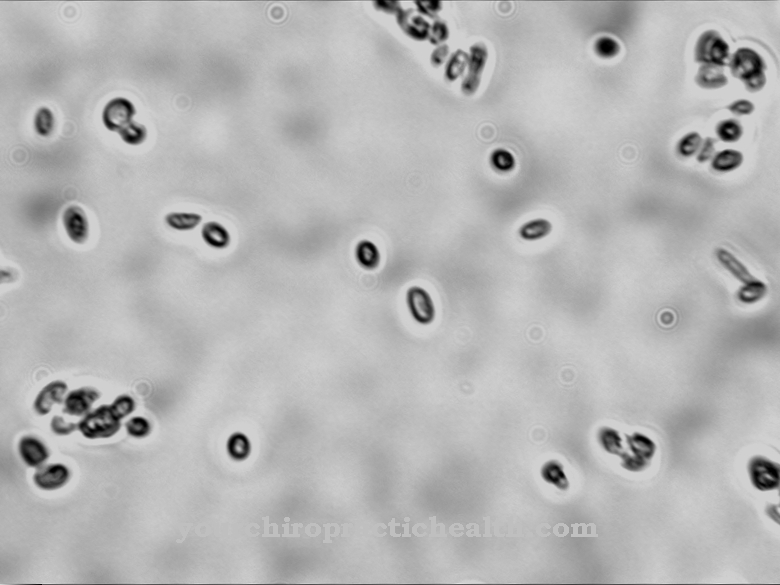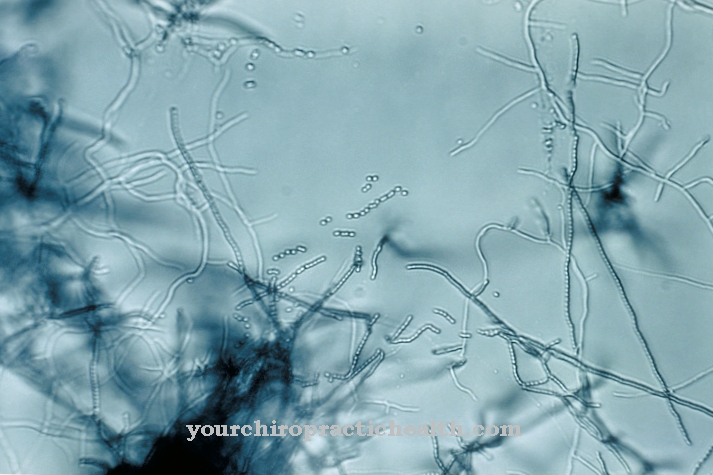Bacteriophage are viruses that infect bacteria and multiply in the process. There is also a specific bacteriophage for each bacterium. Bacteriophages are used in medicine and genetic engineering.
What are bacteriophages?
Bacteriophages are a group of viruses that infect bacteria and archaea (primordial bacteria). In doing so, they continue to multiply, destroying the bacterium.
For each bacterium there is a specific bacteriophage based on the lock and key principle. According to the traditional definition, bacteriophages, like all viruses, are not living beings. They are dependent on a host for their reproduction. No biochemical processes take place outside the host. The phages use their host's enzymes for this.
Bacteriophages only consist of DNA or RNA, which are surrounded by a protein coat. The vast majority of phages, however, have DNA as their genetic material.
Phages were first described in 1917 by the Canadian biologist Félix Hubert d’Hérelle. The structure of the various phages is different. Basically, bacteriophages consist of several components. The main focus was on the structure of the so-called T phages, which also infect the Escherichia coli bacterium.
The T-phages consist of a polyhedral head which is connected to an elongated injection channel (injection device) via a neck. The base plate with tail fiber and spikes is located under the injection device. The head is a capsid that contains nucleic acid. The capsid, injection channel and base plate are made of protein. Tail fibers and spikes serve to anchor the phage to the cell wall of the bacterium.
Occurrence, Distribution & Properties
Bacteriophages are universal. There are about 10 to the power of 30 bacteriophages in seawater. There is also a corresponding phage for each bacterium.
The multiplication of bacteriophages can be divided into five phases. First, the phage is absorbed on a specific cell wall receptor. The ends of the tail threads attach to the cell surface. In the next step, the phage injects its DNA or RNA into the bacterium. The empty protein shells remain on the bacterial surface. The third phase is called the latency phase, in which no phages can be detected. During the latency phase lasting several hours, translation into the viral mRNA and replication into the viral nucleic acid begin. In the so-called production phase, the viral proteins are created. Then, in the subsequent maturation phase, the individual virus components are composed. After virus production is complete, a lysozyme produced by the converted bacterial cell dissolves the bacterium and releases the phages produced.
Meaning & function
Today bacteriophages are already widely used in many areas. Special fields of application open up in medicine, biology or agricultural engineering. In medicine, bacteriophages are used to detect bacterial strains due to their specificity for certain bacteria. This area of application is called lysotype.
Intensive research is currently being carried out into combating bacteria using bacteriophages in infections. This research area is gaining in importance, especially under the influence of the ever increasing number of antibiotic-resistant bacterial strains. However, the poor stability of the phages in the body is problematic. They are immediately eliminated by the body's own phagocytes.
Félix Hubert d’Hérelle has already considered this possible application. However, after the discovery and introduction of antibiotics, the research results on this possible application were completely forgotten. However, the Eliava Institute for Phage Research founded by D’Hérelle in 1934 still exists in Tbilisi, Georgia. Together with the Ludwik Hirszfeld Institute for Immunology and Experimental Therapy from the Polish city of Wroclaw, research is being carried out there today on alternative methods of combating antibiotic-resistant bacteria using phages.
Phages are also used in many different ways in the food industry. For example, various phage sprays are used when packaging cheese or sausages to protect them from bacteria.
Genetic engineering is also a large area of application. For example, phages are now used as vectors for certain genes and introduced into bacteria. Using this method, insulin-producing bacterial strains of Escherichia coli could be generated.
These vectors are also becoming increasingly important for the production of other active substances. In addition, some of them can be used to combat genetic defects.
Illnesses & ailments
However, bacteriophages do not only show positive effects. Some serious infectious diseases only break out with the help of phages. Diphtheria is triggered by the bacterium Corynebacterium diphtheriae. However, the disease can only break out if Corynebacterium diphtheriae is simultaneously infected with bacteriophages. After infection with phages, these bacteria produce the characteristic toxin that causes the severe, sometimes life-threatening symptoms.
The illness begins with signs such as difficulty swallowing, fatigue, nausea and abdominal pain. There is a white coating on the almonds that smells foul, sweet. Often there are complications such as pneumonia or myocarditis, which can be fatal.
Another disease caused by bacteriophages is scarlet fever. Scarlet fever is caused by streptococci infected with bacteriophages. As a result of this infection, the bacteria produce a particularly insidious toxin. There are severe symptoms with chills, fever, vomiting and sore throat. At first the tongue is white, but after a few days it turns raspberry red. A rash also occurs. If the bacterium were not infected with bacteriophage, it would only lead to harmless tonsillitis.
Cholera is also caused by a bacterium infected with bacteriophages called Vibrio cholerae.



























